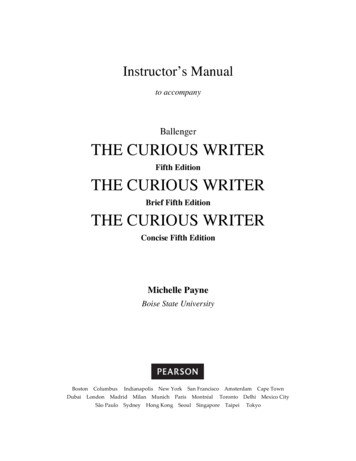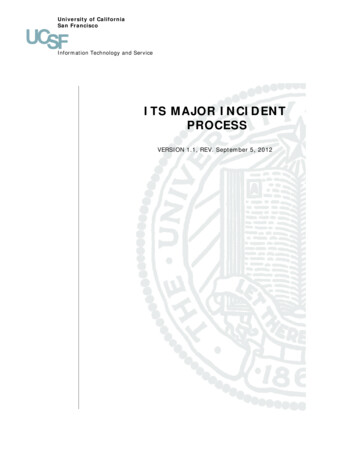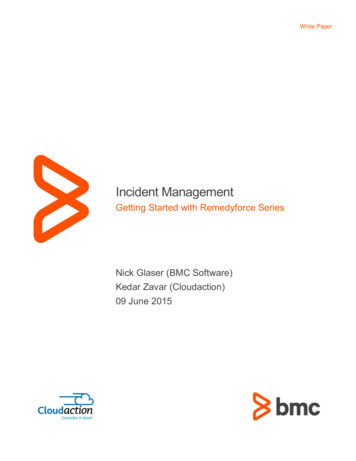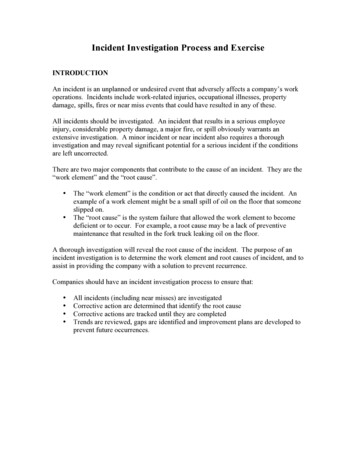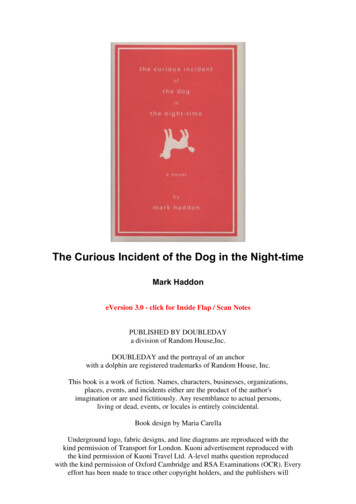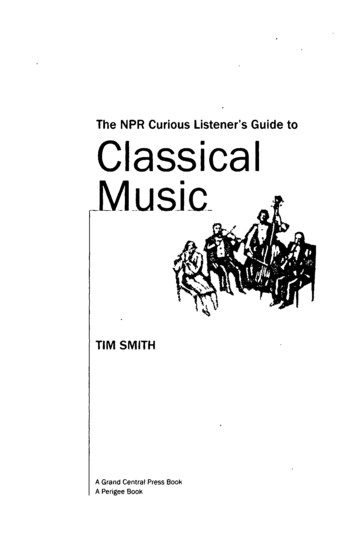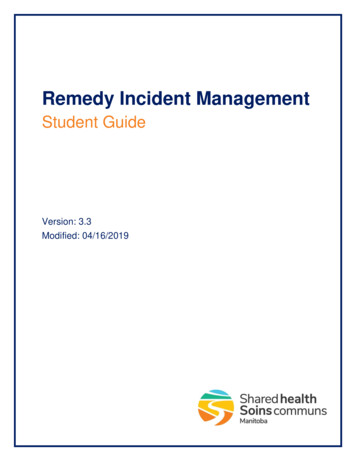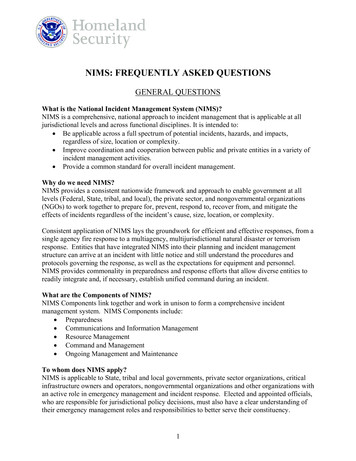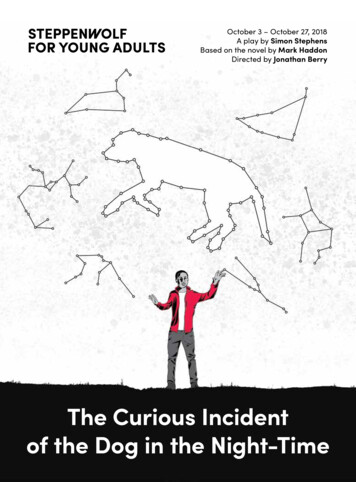
Transcription
October 3 – October 27, 2018A play by Simon StephensBased on the novel by Mark HaddonDirected by Jonathan BerryThe Curious Incidentof the Dog in the Night-Time
IndexWhen You Feel Lost,How Do You Find Your Way?24810121418202226293031Steppenwolf for Young Adults is Proud to Present Dear teachers,This spring Steppenwolf for Young Adults is more thanjust proud, we are ECSTATIC to present Jackie SibbliesDurry’s epic: We Are Proud to Present a PresentationAbout the Herero of Namibia, Formerly Known asSouth West Africa, From the German Südwestafrika,Between the Years 1884 – 1915. (Yep, that’s thefull title!)The play explores what happens when a group ofactors gathers together to give a presentation abouta long-forgotten—or possibly never remembered—genocide, and realize that summaries based onhistory books aren’t nearly enough to capture thecomplexity of human extermination—or humaninteraction. We Are Proud to Present a Presentation tells the story of what happens when, in an effortto dig deeper, the nobly intentioned ensemblecrashes into their own simmering fears andunconscious prejudices, coming face to face withthe potential for brutality in all of us.From Hallie Gordon, Artistic Director of Steppenwolffor Young Adults:“SYA is dedicated to creating work that is bothprovocative and drives us to think harder and deeperabout who we are and the choices we make. We areso excited to be producing We Are Proud to Present aPresentation a powerful story that explores themesof race, representation, storytelling and the powergroup-thinking can have on an individual. Our seasontheme is “When you feel lost, how do you find yourway?” – a question that every character in this playmust ask themselves. SYA hasn’t yet produced a playstructured like this one, and we are thrilled that wehave the opportunity to share it with our audiences.”We hope that you can join us this spring inconversation and exploration! To book your tickets,make sure to visit steppenwolf.org/education whileavailability lasts!The Steppenwolf Education TeamWelcome Letter Curiouser and Curiouser: 29 Facts You Didn’t Know AboutThe Curious Incident of the Dog in the Night-TimeThe Curious Incident of the Dog in the Night-Time Play SynopsisMapping Christopher’s JourneyThe Inhabitants of Swindon, on the Night of Wellington’s DemiseThe Curious Commute of the Student in the Morning Time (Classroom Activity)Disorder or Simply Our DifferencesFacilitating Accommodations: A Conversation with a Sensory ConsultantWhat is Your Truth? (Classroom Activity)Neurodiverse ChangemakersAdditional ResourcesCommon Core State StandardsAcknowledgementsRELAXED/SENSORY FRIENDLY PERFORMANCESaturday, October 27 at 3:00pm (public performance)STUDY GUIDE CURATED BYJared BellotAMERICAN SIGN LANGUAGE-INTERPRETED/OPEN CAPTIONED PERFORMANCEFriday, October 19 at 7:30pm (public performance)Wednesday, October 24 at 10:00am (student performance)ARTICLES BYJared Bellot, Jazmín Corona,Ramona Li, Fatima Sowe,Megan ShuchmanAUDIO-DESCRIBED PERFORMANCE AND TOUCH TOURSaturday, October 20 at 1:30pm tour, 3:00pm curtainEDITED BYMegan ShuchmanDESIGNED AND ILLUSTRATED BYDavid MasnatoSTAFFHallie GordonArtistic Director, Steppenwolf for Young AdultsMegan ShuchmanDirector of EducationJared BellotEducation ManagerJohn RooneyEducation and Leadership Programs CoordinatorAbhi ShresthaEducation AssociateSTEPPENWOLF EDUCATION TEACHING ARTISTSPeter Andersen, Jazmín Corona, Christina El Gamal, Tiffany Fulson, Cara Greene Epstein, Monét Felton, Charles Andrew Gardner,Greg Geffrard, Larry Grimm, Airos Sung-En Medill, Wilfredo Ramos Jr., Fatima Sowe, Mara Stern23
Curiouserand Curiouser:29 Facts You Didn’t Know AboutThe Curious Incident of theDog in the Night-TimeBy Education Intern Ramona LiCurious about how Curious was written? Read on to learn more aboutnovelist Mark Haddon’s inspiration for Christopher, get a better sense ofChristopher’s hometown, and have fun with some trivia about the Tonyaward-winning adaptation of the critically acclaimed novel!5Be Sure to PROJECTThe Broadway Curious production placed a heavy emphasis on constructing spectacles for theaudience. Elaborate projections were used to help immerse the audience and overwhelm theirsenses – giving them the opportunity to experience Christopher’s acute attention to all the detailsthat surround him. Different from the Broadway production, the Steppenwolf for Young Adultsproduction of Curious will instead focus on the relationships between Christopher, his family,and the members of his community.2A Curious NameThe title of Mark Haddon’s book (and this play), The Curious Incident of the Dogin the Night-Time, is a direct reference to The Adventure of Silver Blaze - a storyfrom the Sherlock Holmes series by British author Sir Arthur Conan Doyle. In thestory, Sherlock Holmes discusses with Gregory, a Scotland Yard detective:Gregory: Is there any point to which you would wish to draw my attention?Holmes: To the curious incident of the dog in the night-time.7“My Name is Christopher John Francis Boone.”Haddon has often stressed that he did not set out to write a story about teenagers with AutismSpectrum Disorder (as Christopher is often diagnosed by fans), rather, he wanted to tell the storyof a single young person, and the peculiar way their mind worked – thus, Christopher was born.Haddon himself did take care of individuals with disabilities, including Autism, after graduatingfrom college, the experience of which, in part, did inspire the character of Christopher.Gregory: The dog did nothing in the night-time.Holmes: That was the curious incident.The title directly reflects Christopher’s interest in Sherlock Holmes’s detectivestories. In the novel, Christopher says that “I think that if I were a proper detective[Sherlock Holmes] is the kind of detective I would be”.113And the Winner Is Christopher’s adventure has dazzled audiences all around the globe. After winning arecord-breaking 7 Olivier Awards in 2013, the production made its way from Londonto Broadway in 2014. In addition to winning a Tony Award for Best Play, Alex Sharp,who played Christopher, won the Tony Award for Best Actor in a Play (the youngestever winner of the award). Curious was Sharp’s first professional acting job after hegraduated from college – way to go, Alex!4Prime TimeChristopher is obsessed with prime numbers because, as he explains “Primenumbers are what is left when you have taken all the patterns away. I think primenumbers are like life. They are very logical but you could never work out therules, even if you spent all your time thinking about them.” In the novel, chaptersactually proceed in increasing prime numbers (and in this article, facts proceedin much the same way).5
13Don’t Judge a Book By Its CoverDid you know that there is both an Adult and Young Adult edition of the novel? There is nosignificant difference between the content of the two editions aside from cover designs. The bookwon a Guardian Children’s Fiction Prize. However, Haddon once clarified where his true literaryambition lies: “I sometimes put it like this: I had the second-best job in the world (children’s writer).Greedily, I wanted the best job in the world as well (novelist).”Meet the Steppenwolf Education teaching artists who work onexploring the themes of The Curious Incident of the Dog in theNight-Time with thousands of students across the Chicagolandarea as a part of our In-School Residency Program!17“What sort of Tube?”In the story, Christopher travels on the London Underground for the first time.Why is the London Underground called the Tube? It makes sense if you think of thetunnels the trains travel through! The word “tube” referred to the method used in itsconstruction: “tunneling through the earth and placing segments of iron to line thetunnel, creating a cylinder or tube.” The word “tube” first appeared in an officialadvertisement of the underground railway system in 1905.Peter AndersenJazmín CoronaChristina El GamalAw, Rats!The names of the rat actors featured in the production were voted on by fans. In the London andNew York productions, the role of Toby was portrayed by Splat, Nellie and Marilyn. Tradition holdsthat whenever a new cast starts rehearsing, the actor playing Christopher always meet the ratsfirst, so that they can have as much time for bonding as possible.Tiffany FulsonCharles Andrew GardnerGreg GeffrardA Renaissance ManMark Haddon is not just a novelist - he dabbles in many different art forms! Haddon is quite theaccomplished abstract visual artist. He often illustrates his own literary works! Haddon has alsowritten a number of screenplays for the BBC (British Broadcasting Chanel) including Coming Downfrom the Mountain, which first aired in 2006. The drama features two young brothers, one of whomhas Down’s Syndrome.Cara Greene EpsteinLarry GrimmAiros Sung-En MedillFatima SoweMara SternWilfredo Ramos Jr.192329Round and Round in CirclesSwindon, Christopher’s hometown, is a large town in south England, about 71miles west of London. It is home to a bizarrely shaped traffic circle named“The Magic Roundabout”, which was once voted as the scariest junction in allof Britain. 5 smaller traffic circles are enclosed in this giant conglomerate ofswirliness. No wonder Christopher has a hard time finding places in this town!6Monét FeltonInterested in learning more about our In-School Residency Program?Email Education Manager Jared Bellot at jbellot@steppenwolf.org.7
The Curious Incidentof the Dog in the Night-Time6The next day, when his father is out, Christopher reads the letters and learns that hismother is still alive and lives in London with Mr. Shears. Ed returns home and triesto explain why he lied about his mother’s death, and admits to Christopher that heis the one who killed Wellington after feeling betrayed by Mrs. Shears. Christopherdecides he has to get out of the house and will go live with his mother in London.Play SynopsisBy Teaching Artist Jazmín Corona71Seven minutes after midnight, fifteenyear-old Christopher Boone discovers hisneighbor’s dog, Wellington, dead in the yardwith a garden fork sticking out of its side.Thinking that Christopher is the culprit, Mrs.Shears, Wellington’s owner, calls the police.The police officer questions Christopher andtries to grab him. Christopher screams andhits the police officer because he does notlike to be touched. Ultimately, the police issuehim an official warning and release him tohis father, Ed. Ed asks him to let the mattergo but Christopher makes the decision tofind out who killed Wellington.Christopher begins his long journey toLondon. By asking many questions anddodging the police, he finally arrives athis mother’s doorstep.2At school, Christopher is writing a bookabout his adventures. He tells his teacher,Siobhan, that two years ago, his fathershared that his mother, Judy, was admittedto the hospital and died of a heart attack.Later that day, Ed visits Christopher’s schooland insists that Christopher take his MathA Levels (an advanced standardized exam).He is met with resistance by schooladministration, but it is ultimately decidedChristopher will take the test to place him.Reunited with his mother, Christopherreveals that his father had told him she wasdead. Ed arrives. They have a confrontation.The police arrive and convince Ed to leave.Ed promises Christopher that he will comeback for him.9Judy and Mr. Shears decide Christopher canstay. His stay proves to be challenging foreveryone, especially Mr. Shears. Judy tellsChristopher that she has called the schooland he will take his A-Levels next yearinstead, but Christopher wants to take themnow, as planned. He screams and screams.Judy makes the decision to take Christopherback to Swindon.3Christopher begins his investigationinto Wellington’s murder, speaking withMrs. Shears and the other neighbors onhis street including Mrs. Alexander, whoreveals that Christopher’s mother andMr. Shears (Mrs. Shears’ ex-husband)were having an affair. Christopherdetermines that Mr. Shears is the mainsuspect in his investigation.410Ed reads Christopher’s book which containseverything he knows about his investigationabout Wellington and the things he foundout about his mother. Ed becomes upsetat Christopher for meddling and theirargument turns physical, with Christopherpunching Ed and Ed pushing Christopherover. Ed angrily leaves the house withoutgiving Christopher his book back.In Swindon, Christopher and his motherstay at Ed’s house while they look for anapartment. Back at school, Siobhan letsChristopher know that he can still take hisA Levels if he wants to. He does. Ed triesto regain Christopher’s trust andpromises that in time, their relationshipwill get better.115The next day, Christopher decides to find his book. He looks all over the house and finallyends up in his father’s bedroom. He comes across a shirt box, inside of which he finds hisbook and several unopened envelopes addressed to him in his mother’s handwriting.Hearing his father coming home, Christopher leaves the letters unopened.88Siobhan gives Christopher the results from his A-Levels exam.He receives an A. Christopher begins spending more time with hisfather and he shares his plans to take future A level tests, go toUniversity, and become a scientist. “I can do these things,” he says.9
Mapping Christopher’s JourneyBy Teaching Artist Fatima SoweFor American audiences, many parts of Christopher’s journey may seemunfamiliar to us due to differences in language from our friends acrossthe pond. Check out the map below to navigate your way through thestory for a deeper understanding of the play:Garden ForkDon’t worry, Wellington wasn’t murdered by a kitchen utensilused to eat salad -- he was however murdered by a gardentool called a garden fork that is primarily used to loosen andturn over soil. Garden forks though not specific to the UK areoften confused with pitchforks which are still pronged, butlighter and used for pitching hay.CautionAfter Christopher hits a police officer in Mrs. Shears’ yard the night ofWellington’s murder, he is issued a caution as opposed to being placedunder arrest. A caution is a recorded warning issued to anyone over theage of 10 for minor offenses, though you must agree to the offence inorder to be cautioned. That said -- not agreeing to the offence could leadto arrest, so it’s in your best interest to go along with it!Cashpoint CardBefore leaving for London, Christopher stealshis father’s cashpoint card to help pay for histrain tickets. A cashpoint card is just like anATM/Debit Card.10Willesden, LondonLondon is HUGE and is home to 48 differentneighborhoods (for reference, Chicago is 234square miles to London’s 671 sq miles!). So whenChristopher gives his address at the informationdesk at the train station, only indicating 451cChapter Road – it’s no wonder no one knowshow to help him. Christopher amends his answerto include Willesden, a postal mailing zone in theto help orient (it’s sort of like saying SteppenwolfTheatre is located at 1700 N. Halsted, LincolnPark, Chicago, IL).Swindon StationChristopher sets out on his journey to London’s PaddingtonStation from Swindon Station. In addition to being Christopher’shome, Swindon is also historically significant as a famousrailroad city where trains were manufactured in the 19th andmuch of the 20th centuries, and as a point halfway between twomajor cities, Bristol and London.Bakerloo LineChristopher is on the Bakerloo Brown Line for about 15minutes from Paddington Station to Willisden Junction.The Bakerloo is one of the London Underground’s 11lines. The Bakerloo serves 25 of the Underground’s270 stations. It also has the oldest trains-cars on theLondon Underground. Fun fact: you can follow the lineon Twitter @bakerlooline.Paddington StationChristopher’s final destination on his train journey isPaddington Station. Paddington serves not only as the terminusfor the Great Western Rail which connects London to the greaterUK, but also as the central hub for the London Underground(Tube) the city’s public rail transport, our CTA equivalent.ComplanIn London, Christopher’s mom Judy needs for him toeat something and offers him Complan -- Rogerdisparagingly scoffs at this because Complan is anutritional supplement drink for individuals who havedifficulty eating and staying well nourished.First Class HonorsChristopher intends to graduate from a collegewith a first class honors degree, studyingscience. This is the equivalent of graduatingfrom college with the highest academic honor,Summa Cum Laude -- meaning thatgrades qualify to be within the top 15%of the graduating class.A-Levels MathChristopher is way ahead of the curve takinghis math-A-levels at the early age of 15!In the UK, most students take their A-Levelexams (which are the higher of two levels ofstandardized testing focusing on a specific areaof study) around the age of 18 or 19. Studentsinterested in pursuing undergraduate studiesenroll in A-Level courses after the completionof their Secondary Education (whichroughly equated to junior year of high school)and spend two years preparing for the exams.11
The Inhabitants of Swinden onthe Night of Wellington’s Demise:Character DescriptionsSiobhan (played by Steppenwolf Ensemble member Caroline Neff):A teacher at Christopher’s school who mentors him on essential life skills.Genuinely concerned with Christopher’s well-being, she is his guidingpost as he navigates the complexities of society.By Education Intern Ramona LiMeet the characters of Curious that make up Christopher’s community.As he investigates the murder of Wellington, several different people shape hispath on his journey of discoveries. In Steppenwolf for Young Adults’ productionof Curious, some actors will also be a part of the Ensemble, meaning that theywill play multiple characters and voices throughout the story.My name is Christopher John Francis Boone. I live at 36 Randolph Street,Swindon, Wiltshire. I know all the countries of the world and capitalcities. And every prime number up to 7,507.– Christopher BooneToby:Christopher’s pet rat who joins Christopheron his journey to London.Wellington:Mrs. Shears’s dog, a black poodle. Found dead inMrs. Shears’s garden with a garden fork stickingout of the side of his body.Mrs. Alexander (played by Meg Thalken):A friendly woman in Christopher’s neighborhood whooffers him treats and aids him in his investigation.Christopher Boone (played by Terry Bell):A teenager with an extraordinary mind, Christopher Boone is the protagonist of our story.He is fascinated by stars, the universe, and math, which he excels at. Christopher findsinteracting with others puzzling, and prefers being given time and space for solitarycontemplation. Equipped with a black-and-white sense of morality, he is determinedto investigate the murder of Wellington (his neighbor’s dog) despite the disapprovalof his father.Ed Boone (played by Cedric Mays):Christopher’s father. He lives alone with Christopher inthe family home. Although a bit hot-tempered at times,he harbors much gentleness for his son.Judy Boone (played by Rebecca Spence):Christopher’s mother. She loves Christopher immensely, but is often wornout by Christopher’s tantrums. Two years before Christopher discoversWellington, she disappeared. Christopher’s father dishonestly informedhim that she died of a heart attack.12Mrs. Shears (played by Eunice Woods):The Boones’ next door neighbor, and Wellington’sowner. She kindly cared for Christopher after his motherdisappeared, but becomes upset at Christopher at thestart of the play, thinking that he killed her dog.Mr. Roger Shears (played by Scott Allen Luke):Mrs. Shears’ husband who now lives in London.Christopher’s primary suspect in his investigation.Reverend Peters (played by Christopher M. Walsh):A priest at Christopher’s school who discusses theexistence of heaven with him.13
The Curious Commuteof the Student in the Morning-Time:5 minsSTEP THREE – GLANCING OUT OF THE WINDOWInstruct students to again take the same trip from Point A to Point B, this time focusing theirrecall by choosing one sense from the following: TASTE, SMELL, HEARING, SIGHT, TOUCH andexperiencing the journey entirely from that sense, writing down as many details as possible onpage 16 in D: Sensory Focus. Students might consider the following: What do you see? What doyou hear? What do you smell? What can you feel? At what points in the journey do you feel anoticeable change? What makes those shifts in sensing significant? Are there patterns alongthe way – can they be described quantitatively? (i.e. 73 honking horns, 14 flashing lights,3 mugs of coffee, etc.)A Classroom ActivityBy Teaching Artist Fatima SoweACTIVITY TIME: This activity (as outlined) is designed for 45 minutes; to be conducted beforeor after students see the show.D: SENSORY FOCUSIn the play The Curious Incident of the Dog in The Night-Time, Christopher looks out the window of a moving trainand notices the countryside, remarking:Ex: The sound of jackhammers drilling, honking horns, starts quieter – sounds of families,kids on their way to school – gets louder the closer you get to the center of the city,more honking horns, the sound of trucks, etc., hearing the lyrics to “Sunday Candy.”“I see everything. Most other people are lazy. They never look at everything. They do what is calledglancing, which is the same word for bumping off something and carrying on in almost the same direction.And the information in their head is really simple.But if I am standing looking out of the window of a train on to the countryside I notice Everything. Like15 mins1. T here are nineteen cows and in the field. Fifteen of which are black and white and four of which arebrown and white.STEP FOUR – MAP MAKINGUsing these two lenses soft focus and sensory focus, students will make a memory map of theircommute to school on page 17 in E: Map Making. These maps can be literal, figurative orabstract. The objective is simply that the students are to draw from their memory to describethis journey in a way that makes sense to them. (See sample of page 16 of guide.)2. T here is a village in the distance, which has thirty-one visible houses and a church with a square towerand not a spire ” How often do we experience our own lives and travel with such exquisite detail and attentive focus to the worldaround us? What if we all applied a Christopher-level of focus to the otherwise “glanceable” routines in ourlives? This activity challenges students to recollect the details of an everyday journey, accessing all those detailsthrough memory. What do we pay attention to and what do we ignore when we navigate in the world?Each map must clearly indicate Point A and B (i.e. Home and School)Each map must represent two words from our Soft Focus lens. (i.e. Ashland Ave)Each map must embody the chosen Sensory Focus lens. (i.e. Hearing, all the lyrics toChance’s “Sunday Candy” the only song I listen to on repeat on my way to school.)Tip: If you are having difficulty, think of maps that you use regularly from Google Maps,to the CTA map and start there!5 minsSTEP ONE – DEPARTURES AND ARRIVALSOn the handout located on page 16 of this guide, have students identify their commute toschool, noting the A: Point of Departure and B: Point of Arrival.5 minsA: POINT OF DEPARTUREB: POINT OF ARRIVALEx: My homeEx: My schoolC: SOFT FOCUSEx: Ashland Avenue, cars, people riding bikes, black asphalt, potholes,orange construction signs, etc.STEP FIVE – MAP LOST AND FOUND!Have students display their maps around the classroom and take part in a silent gallery walkexploring their classmates’ works of art.Guided Questions:What do you see? What do you notice? What is familiar and discernable –can you decipher where this map is coming from? What might be a clue as to where that is?What does this map tell you about the author? What do you wonder and what areyou curious about?STEP TWO – GLANCING OUT OF THE WINDOWFacilitate the recollection of the commute for your students using the lens of soft focus.Ask students to imagine their commute (from start to finish) 1-3 times with their eyes closed,by simply “glancing” at their surroundings. While reflecting, guide students to think generallyabout the following details: What landmarks do you see? What street names? Types ofTransportation? Advertisements? People? Detours? Barriers? Colors? Sounds? Fabrics?Temperatures? Have students write down their noticings on page 16 in C: SOFT FOCUS.145 mins10 minsSTEP SIX – REFLECTION/CLASS DISCUSSIONSilently or as a group, have students reflect based on the following questions:Did you find any similarities between the map you created and the partner’s mapyou explored? What was similar or different?What did you notice about the journey someone else took with your map?What do we pay attention to and what do we ignore when we navigate in the world?How is this similar or different from what Christopher pays attention to?15
E: MAP MAKINGNAME:A: POINT OF DEPARTUREB: POINT OF ARRIVALC: SOFT FOCUSGlancing at the landscape of your commute, what are the general things you notice?(i.e. What landmarks? Street names? Types of Transportation? Advertisements? People? Detours?Barriers? Colors? Sounds? Fabrics? Temperatures?)D: SENSORY FOCUSFocusing on a specific sense (sight, hearing, smell, taste and touch), spend more time exploring the detailsof your commute – what are the details that you notice?MAP MAKING: EXAMPLE MAP1617
Disorder or Simply Our Differences?What does it mean when we say “Neurodiversity?”By Education Intern Ramona LiAuthor Mark HaddonIn The Curious Incident of the Dog in the Night-Time, we are given a glimpse into theinner landscape of Christopher Boone. At the train stations he visits throughout hisjourney, Christopher experiences a sensory overload from the bedazzling sounds andsights. In this moment, he is not just struggling with navigating an unfamiliar place,but also with a hypersensitivity to and hyperawareness of his surroundings. You maywonder if Christopher has Autism Spectrum Disorder - a developmental disordercharacterized by challenges with non-verbal communication, difficultiesunderstanding figurative language and fixation on narrow topics. While thesediagnostic labels may be consistent with some of Christopher’s behavior, through thelens of Neurodiversity, we may look at the story, and at Christopher in a new way.PRACTICING EMPATHY AND UNDERSTANDINGWe do not have a way of being fully in another person’s head or completely taking on another’s perspective.As such, Curious highlights the importance of practicing empathy and understanding in our day-to-day lives.Mark Haddon, author of the novel, cautions readers:“I’ve always regretted that the phrase ‘Asperger Syndrome’ appeared on the cover of Curious Incident when itwas first published. Mostly because the central conceit was that Christopher himself had written the book (for along time it had the dull but accurate working title, Christopher’s Book) and ‘Asperger Syndrome’ is not a phrasehe uses. In the book he refers to himself only as ‘someone who has Behavioural Problems’ I prefer the wry humour in these words. I like the way it gently mocks the diagnostic medical language.I like the way it includes all of us (who doesn’t have behavioural problems?). But I like it most of all because it isChristopher’s own phrase. Labels tell us very little about the person who has been labelled and a lot about thepeople doing the labelling. If you want to find out who someone is, just ask them.”WHAT IS NEURODIVERSITY?Neurodiversity is a concept where neurological differences are to be recognized and respected as anyother human variation.According to Haddon, the primary focus of Curious is to present the world through Christopher’s eyes. His goal increating Christopher was to construct a character who sees the world differently than the vast majority of theircommunity. Christopher was not meant to be a prototype for Autism Syndrome. In fact, in both the book and theplay, Christopher is never diagnosed with any one type of developmental disorder. Haddon hopes to explore thisparticular story of this teenage boy with a particular mind. Through the lens of Neurodiversity, he reminds usthere are many different ways in which people see and experience the world. With Christopher, Haddon asks usto look beyond the simplicity of a label to truly understand someone. He warns us that, when treated as a shortcut for knowing others, labels actually prevent us from truly understanding the experience of anotherhuman being.The concept of diversity is not unfamiliar to us. Over the course of the past century, many social movementsfought to ensure fair treatment for different gender, racial, ethnic, and socioeconomic groups. Neurodiversityevokes a similar concept that acknowledges diversity of experience is natural -not just basic emotions likehappiness or sadness, but all sensations and perceptions. It proposes that all the different ways in which weexperience the world reflect our individuality. Unique as each of them are, they are all worthy of recognition.This message from Haddon parallels existing efforts to normalize cognitive disorders in mainstream culture.Neurodiversity is the foundational value in these advocacies. The essence of the argument for Neurodiversityis that there is no binary of “good” and “bad” neurological traits. Granted, certain neurological traits can makenavigating society more difficult. So, what do all of us need to do to make adjustments to our world to make iteasier to navigate for all?Neurodiversity is a concept where neurological differences are to berecognized and respected as any other human variation.Labels tell us very little about the person who has been labelled anda lot about the people doing the labelling. If you want to find out whosomeone is, just ask them.– Mark Haddon18Ask yourself as you continue to explore Curious: how is Christopher’s world differen
The title of Mark Haddon's book (and this play), The Curious Incident of the Dog in the Night-Time, is a direct reference to The Adventure of Silver Blaze - a story from the Sherlock Holmes series by British author Sir Arthur Conan Doyle. In the story, Sherlock Holmes discusses with Gregory, a Scotland Yard detective:
